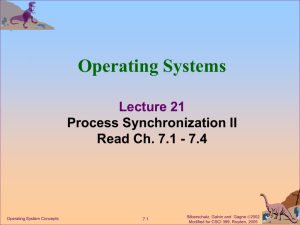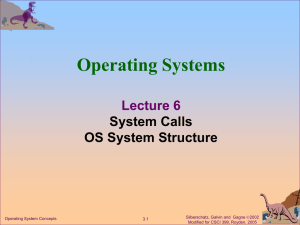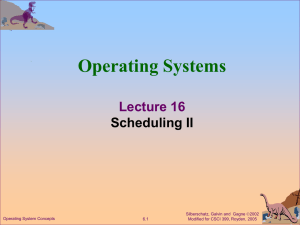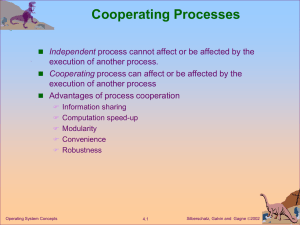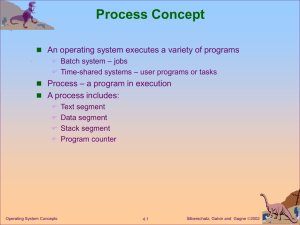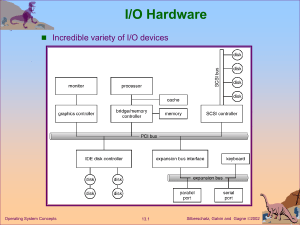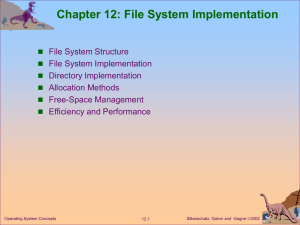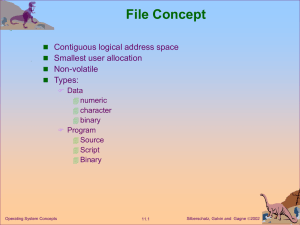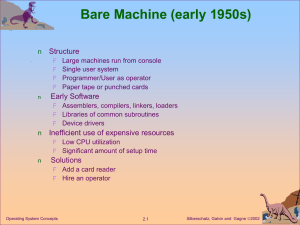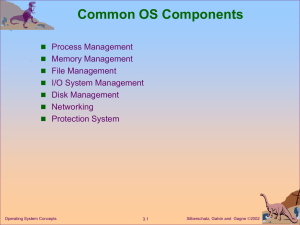Lecture 34
advertisement
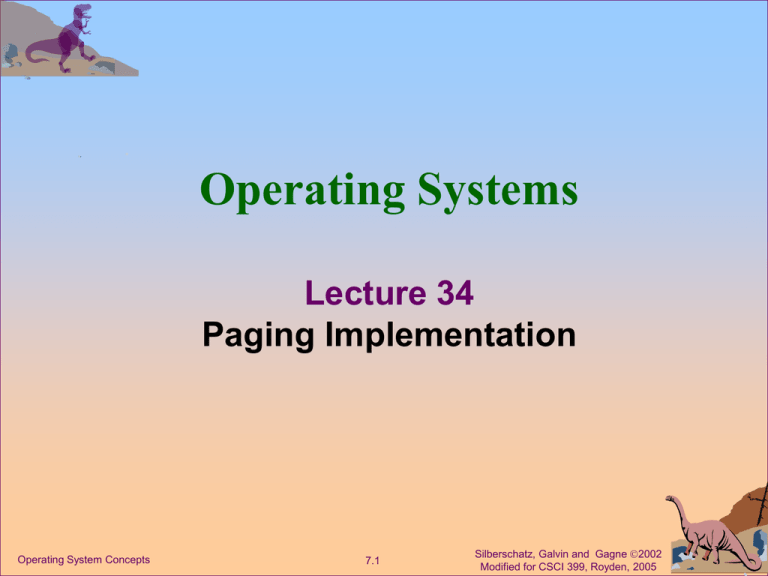
Operating Systems Lecture 34 Paging Implementation Operating System Concepts 7.1 Silberschatz, Galvin and Gagne 2002 Modified for CSCI 399, Royden, 2005 Implementation of Page Table Recall: Simplest implementation: Page table stored in dedicated registers in the CPU. The registers use high speed logic. The CPU dispatcher re-loads these registers when switching processes. (Each process has its own page table). This method is only useful when the page table is small (< 256 entries). Most contemporary computers have much larger page tables (106 entries) so this method will not work well. Operating System Concepts 7.2 Silberschatz, Galvin and Gagne 2002 Modified for CSCI 399, Royden, 2005 Storing Page Table in Main Memory For large page tables, the page table is kept in main memory. Page-table base register (PTBR) points to the page table. When changing processes, only need to change 1 register to change page tables. This reduces the context switch time. Page-table length register (PTLR) indicates size of the page table. Drawback: In this scheme every data/instruction access requires two memory accesses. One for the page table and one for the data/instruction. Operating System Concepts 7.3 Silberschatz, Galvin and Gagne 2002 Modified for CSCI 399, Royden, 2005 Translation Look-Aside Buffer (TLB) The two memory access problem can be solved by the use of a special fast-lookup hardware cache called associative memory or translation look-aside buffers (TLBs) This kind of memory is expensive, so it is generally small (64 - 1024 entries). In each memory access, the TLB is searched first to locate the page number. If the page is found (a hit) the associated frame is used to access the data in memory. If the page is not found (a miss), the page number is looked up in the page table in main memory. The page number and associated frame is added to the TLB. Operating System Concepts 7.4 Silberschatz, Galvin and Gagne 2002 Modified for CSCI 399, Royden, 2005 TLB: Associative Memory Associative memory – parallel search Page # Frame # Address translation (Page #, Frame #) If page# is in associative register, get frame # out. Otherwise get frame # from page table in memory Operating System Concepts 7.5 Silberschatz, Galvin and Gagne 2002 Modified for CSCI 399, Royden, 2005 Paging Hardware With TLB Operating System Concepts 7.6 Silberschatz, Galvin and Gagne 2002 Modified for CSCI 399, Royden, 2005 Effective Access Time (EAT) Effective access time (EAT) is the average time needed to access memory. Hit Ratio: The percentage of times that a particular page number is found in the TLB. Effective access time can be calculated based on: The time it takes to access main memory The time it takes to access the TLB The hit ratio for the TLB Example Time to access main memory = 100ns Time to access TLB = 20 ns Hit ratio = 0.8 (80%) If page is found in TLB, total access time = ? If page is not found in TLB, total access time = ? Effective access time = ? Operating System Concepts 7.7 Silberschatz, Galvin and Gagne 2002 Modified for CSCI 399, Royden, 2005 General Formula for EAT Hit ratio = a Main Memory access time = m Associative Lookup (TLB access) = e EAT = (m + e) a + (2m + e) (1 - a) = 2m - ma + e Operating System Concepts 7.8 Silberschatz, Galvin and Gagne 2002 Modified for CSCI 399, Royden, 2005 Memory Protection Memory protection implemented by associating protection bit with each frame. Bits signal if a frame is read only, read-write, execute only or a combination. Valid-invalid bit attached to each entry in the page table: “valid” indicates that the associated page is in the process’ logical address space, and is thus a legal page. “invalid” indicates that the page is not in the process’ logical address space. Example: System has 14 bit address space (0 - 16383) Program uses addresses 0 - 10468 Page size = 2 KB (2048 = 211) # of pages = ? 6 pages needed by program (5 pages = 5*2048 = 10240Bytes) Pages 0 - 5 have valid/invalid bit set to valid Other pages have bit set to invalid. Operating System Concepts 7.9 Silberschatz, Galvin and Gagne 2002 Modified for CSCI 399, Royden, 2005 Valid (v) or Invalid (i) Bit In A Page Table Operating System Concepts 7.10 Silberschatz, Galvin and Gagne 2002 Modified for CSCI 399, Royden, 2005 Problem with large page tables Modern computers have large logical address spaces: 232 or 264 bytes. This can make page tables excessively large. Example: 32 bit logical address space 4 KB Page size How many entries in the page table? If each entry is 4 bytes, what is size of each table? With large page tables, it is good not to store them continuously in memory. Operating System Concepts 7.11 Silberschatz, Galvin and Gagne 2002 Modified for CSCI 399, Royden, 2005 Hierarchical Page Tables In hierarchichal page tables, the logical address space is broken up into multiple page tables. A two-level example: A logical address (on 32-bit machine with 4K page size) is divided into: a page number consisting of 20 bits. a page offset consisting of 12 bits. Since the page table is paged, the page number is further divided into: a 10-bit page number. a 10-bit page offset. Thus, a logical address is as follows: where p1 is an index into the outer page table, and p2 is the displacement within the page of the outer page table. page number pi 10 Operating System Concepts page offset p2 d 10 12 7.12 Silberschatz, Galvin and Gagne 2002 Modified for CSCI 399, Royden, 2005 Address-Translation Scheme Address-translation scheme for a two-level 32-bit paging architecture Operating System Concepts 7.13 Silberschatz, Galvin and Gagne 2002 Modified for CSCI 399, Royden, 2005 Two-Level Page-Table Scheme Operating System Concepts 7.14 Silberschatz, Galvin and Gagne 2002 Modified for CSCI 399, Royden, 2005 Hashed Page Tables Common in address spaces > 32 bits. The virtual (logical) page number is hashed into a page table. This page table contains a chain of elements hashing to the same location. Virtual page numbers are compared in this chain searching for a match. If a match is found, the corresponding physical frame is extracted. Operating System Concepts 7.15 Silberschatz, Galvin and Gagne 2002 Modified for CSCI 399, Royden, 2005 Hashed Page Table Operating System Concepts 7.16 Silberschatz, Galvin and Gagne 2002 Modified for CSCI 399, Royden, 2005 Inverted Page Table One entry for each real page (frame) of memory. Entry consists of the virtual address of the page stored in that real memory location, with information about the process that owns that page. Decreases memory needed to store each page table, but increases time needed to search the table when a page reference occurs. Operating System Concepts 7.17 Silberschatz, Galvin and Gagne 2002 Modified for CSCI 399, Royden, 2005 Inverted Page Table Architecture Operating System Concepts 7.18 Silberschatz, Galvin and Gagne 2002 Modified for CSCI 399, Royden, 2005 Shared Pages Shared code One copy of read-only (reentrant) code shared among processes (i.e., text editors, compilers, window systems). Shared code must appear in same location in the logical address space of all processes. Private code and data Each process keeps a separate copy of the code and data. The pages for the private code and data can appear anywhere in the logical address space. Operating System Concepts 7.19 Silberschatz, Galvin and Gagne 2002 Modified for CSCI 399, Royden, 2005 Shared Pages Example Operating System Concepts 7.20 Silberschatz, Galvin and Gagne 2002 Modified for CSCI 399, Royden, 2005
